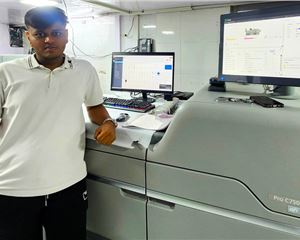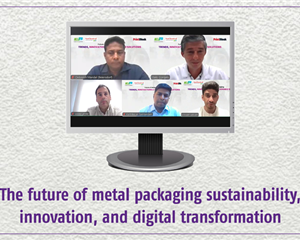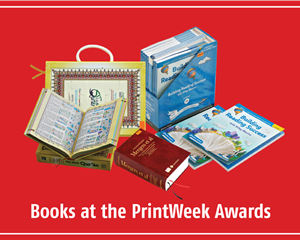Digital is growing at 35% in India
The cut-sheet digital print market is taking off with three-billion impressions per annum. A report by Samir Lukka and Ramu Ramanathan scrutinises the Rs 1800-2000 crore market and suggests that things could actually get a lot better.
02 Nov 2011 | By Rahul Kumar
Inspired by the early digital systems in 1985, Romano held the world’s first conference about on-demand printing. Yet it has taken more than 20 years for the concept to enter mainstream production. Could this lengthy adolescence be partly due to digital knowledge and digital pricing not understood by print CEOs? If so, there’s room for improvement.
The numbers, we have arrived at: 1,500 colour digital machines have been installed in India during the last five years. The reason, we have considered five years is, it is considered the life of a digital press in India. As Puneet Datta of Canon India pointed out at the Ipex South Asia, "High-end and continuous feed kit like Oce has a longer life-span."
Out of these 1,500 cut sheet presses, there are 900 light production machines, 400 mid-production presses; and around 200 high-production systems which include continuous feed like Oce, Kodak, Xerox.
We don’t have the numbers for Xerox as yet; except for the 25 iGens (including the newly launched Xerox 1000). Even today, it’s clear that Xerox remains the market-leader with more than 50% market-share.
HP Indigo has 93 installations. Canon has notched up 75 installs.
Kodak has 34 monochrome Digimasters; and 13 Nexpress.
Ricoh which inked ten deals at Ipex South Asia, has installed 20 ProC720/720S and Pro C901/901S colour devices in the past nine months. Pro 907ex/1107ex/1357 has notched up 20+ b/w devices installations in 2010-11 time-frame.
Konica Minolta series which has been dominating the low production since October 2009 has 550 installations. The break-up is: 300 HCL; 200 Monotech; and 50+ KMI Business Technologies.
A dark horse in this range primarily for the extended length substrate support are the DP60 Pros and now the DP8700 XL from MGI. India has 30 installations of all the machines of MGI which includes the earlier versions of the digital press DP40 and DP60.
Digital v/s offset
The future for digital print in India looks good, even though its a miniscule proportion of the 11 million tons consumed by offset presses in the country. A fact which was endorsed by most of our panelists at the Ipex South Asia Red Sofa session. Nilesh Shah of KMI states, "The segment is buoyant and for Konica Minolta it is growing at 20%."
But what do Indian print CEOs really think about digital print? Even today, high-volume monochrome accounts for the largest proportion of digital jobs. As Shailesh Sharma of Inndus, says, "Quick turnarounds and economy for short-runs have also found favour among procurement people. There are certainly digital presses that can produce quality almost on par with litho."
And yet, there is a popular perception that digital technology is limited in what it can achieve.
Sharma adds: "Digital is geared towards A3 and can’t cope with substantially heavier weights or complex jobs. But when producing a text-heavy job, you won’t notice the difference from litho."
The point is, digital is much more than a one-trick pony for short-run work. It offers a host of other value-adding options that can actually inspire campaigns, while also providing better response rates and return on investment. A Appadurai of HP, explains: "Digital is harder than just buying print. It is important buyers understand the products, know what kit firms have and what they can offer. It is then up to the buyers to inform marketers so they can incorporate the processes into campaigns."
HP, which has been hosting a series of buyer-seller meets has interesting pointers. When we attended the sessions for HP Indigo customers (Kris Flexipacks in Mumbai and SGRE in Bengaluru), we found that buyers tend to look past the initial costs of digital and instead focus on the additional returns promised by a well-designed job. Also, firms can make marketing campaigns work much harder by accurately targeting consumers, both as demographics and as individuals. When researching digital, it’s not enough to just look at a printer’s samples.
Instead, buyers should use the plant list to analyse a firm’s digital capabilities. Recognising what applications can be produced on what equipment is crucial to making profitable marketing decisions.
Application driven growth and usage patterns
The other thing discernible thing at Ipex South Asia was the profile of the visitors. Other than the usual players who constitute the Indian digital market place: B2C (Print Bazaar, Friends, etc) and B2B (firms at units A to Z, Shah and Nahar and Nehru Place); there were representatives from media houses, agencies and even the big brands.
As Anjana Saha of Ricoh states: "Today, buyers are up to speed on digital technology – and they inform their marketing teams of the opportunities available to them, even to the point of changing the entire focus of a marketing campaign by opting for more tangible, targeted and relevant print. To rally against diminishing print budgets, buyers are showing that print is a valuable resource."
Most of the digital manufacturers have identified seven major applications expected to feed the growth of digital printing. These include short-run, colour marketing collateral and books-on-demand. In addition, we feel catalogue printing will grow through the integration of dynamic content. Colour labelling with versioned content is also evolving rapidly, as is the transpromo sector, where promotional content is integrated into transactional documents, such as bills and statements. But digitally produced direct mail is claimed to have the largest growth potential: highly targeted marketing fits perfectly with digital’s variable printing capabilities.
Some interesting trends to look out for are the usage patterns.
The growth of B2B among offset printers transferring or preferring to have digital press for short run is in the <500 impressions. While growth in B2C is towards personalisation; and a pie from the screen print segment. As Appadurai states: "Photo book applications hold the key."
The second step we undertook was to look at average printing volumes that the industry produces per month.
The numbers for the big cities are: Light production colour produces 10,000 per month. Mid-production produces 35,000 per month and high production is 65,000 per month.
These numbers were challenged by our Red Sofa panelists. Saha of Ricoh says, the C751 Ricoh press can go up to 65,000 per month; whilst Durai of HP says the HP Indigo customer "got 50,000 earlier but now it is 95,000." Durai states: 50,000 is break-even for a HP Indigo user."
Working with these numbers we said, in the high segment (65,000 to 95,000 impressions per month) there are perhaps 125 units that include the Nexpress, iGen3 and iGen4, HP 3500 and 5500 in the country.
However, for the all-out headline-grabbing announcements, nothing created quite so much chatter as the gains in the smaller cities, the volumes are not very high; and the numbers are lower but the real action is transpiring in centres like Surat and Punjab. As V Natarajan of Aura Papers, the dealer for MGI presses in India, says, "The targeted market is not limited to the mega-cities and the b-cities. We can see the numbers improve in tier-1 and tier-2 centres and even tier-3 centres like Nagercoil and Kanyakumari."
Colour v/s monochrome
So what is the size of the Indian digital market?
We tried to compute the above matrix with the aid of our Red Sofa panelists. Pankaj Kalra of Xerox India says: "The colour digital print cut-sheet market is Rs 800-cr to Rs 1000-cr in India."
In real terms this can be translated into: If we multiply the above matrix one gets 30 million colour prints a month. Likewise a calculation for B&W machines, we got a figure of 300 million prints a month (say 600 machines doing five lakh a month average).
Now there are unusual market-places like Nehru Place in Delhi which is a one million per month market. Dhiren Dhaiya of Print Bazaar (who have set up five retail outlets in Delhi) says: "30 million seems to be on lower side. My guess is, it will be 45-50 million impressions."
Dhariya feels the calculations should be: 50 million per month colour prints and 300 million B&W.
This amounts to a total of 350 million prints a month. This is approximately three billion-plus prints a year.
Is this a conservative number?
Alok Bharadwaj of Canon says: "I would say 2.2 billion is a good number. Anything above this number is coming from reconditioned machines. For example; Nehru Place has a reconditioned machines installed base." Bharadwaj adds: "At the end, we can assess that 20% of colour and 50% of B&W production prints in India are produced from the reconditioned base."
Model for pre-owned in digital
This means, of the 1,500 installed base of "legitimate machines", there may be a 1,000 (mostly low-production) base in reconditioned machines.
Again, there is contrarian point of view. A dealer spoke to us on the condition of anonymity, "There are "very ‘near to original’ toners for Xerox and Canon devices being imported into India. Approximately five containers per month are imported from China and from the US.
Today, Singapore, Hong Kong and US are the hubs for a pre-owned colour duplicating digital press and graphic digital press. And so, container loads are cleared from ports of India."
Speaking about the re-conditioned market, Avijit Mukherjee of Ricoh says, "There is a sizeable grey market but I feel that these machines create an entry point for the smaller print firm to enter into digital. This eventually leads them upgrading to brand models which have the capacity to fulfill their growth in demand of premium applications and higher volumes."
Xerox has a different strategy. Kalra of Xerox points out, "Under the Xerox Certified Economic Value (CEV) scheme, we help our existing customers in upgrading their current equipment with greater and more advanced technologies through the Xerox Trade-in program."
And so, the trade-in Xerox equipment is refurbished at a dedicated facility in Bengaluru and reintroduced into the market under the CEVprogram. It is an important initiative in the digital print industry of India and offers a great value proposition to the printers, who are looking at ways to invest in an affordable digital press to help complement their existing litho business.
The models vary from the entry-level DC 12 and the DC 250, to the Xerox 700, DC 5252, DC 6060, DC 5000s etc. The cost of the refurbished equipments varies from model-to-model as well as the balance serviceable life of the equipment.
Conclusion
The "Digital Ipex" in Mumbai showed how the process has matured in the b/w space and photo albums. Also it showed how it is making a play for the production print market. Market watchers say, this transition will not always be steady. So as 2011 closes, all eyes should turn to new markets, new strategies and new applications in the hope of expanding the market-base.
Our understanding is: Today, India produces not more than three billion digital prints a year in cut-sheet digital. Out of this, 15% seems to be colour. Multiplying this by the rate that the end customer pays (Rs eight for colour and 30 paise for B&W), the market value of this industry is Rs 1800-crore.
"We need to wait and watch. India is still taking baby steps in this industry," says Dhiren Dhaiya, whose company Print Bazaar has five digital stores in Delhi. This number is expected to touch 13 in Delhi by the end of year and could include a DI press.
Does this mean, Rs 1800-crore could be a conservative number?
Milap Shah of PrintStop who has eight Bizhub Pro machines from Konica Minolta sums it up best. "Digital print is a communication medium. What makes it interesting is the ‘you’ appeal. It’s not just about knocking out jobs on an iGen or a Bizhub."
To sum up: Digital print is growing. And it is doing so, rapidly at 35%.












 See All
See All